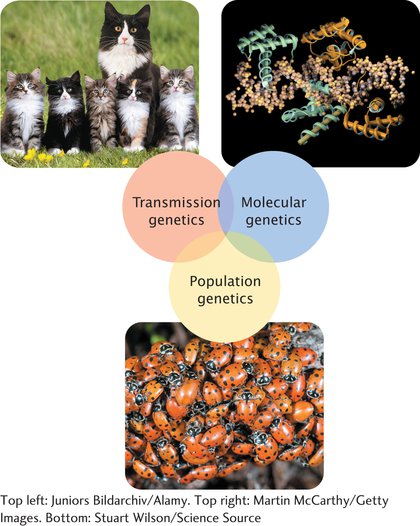Divisions of Genetics
The study of genetics consists of three major subdisciplines: transmission genetics, molecular genetics, and population genetics (Figure 1.6). Transmission genetics (also known as classical genetics) encompasses the basic principles of heredity and how traits are passed from one generation to the next. This subdiscipline addresses the relation between chromosomes and heredity, the arrangement of genes on chromosomes, and gene mapping. Here, the focus is on the individual organism—

Molecular genetics concerns the chemical nature of the gene itself: how genetic information is encoded, replicated, and expressed. It includes the cellular processes of replication, transcription, and translation (by which genetic information is transferred from one molecule to another) and of gene regulation (the processes that control the expression of genetic information). The focus in molecular genetics is the gene—
Population genetics explores the genetic composition of groups of individuals of the same species (populations) and how that composition changes over time and space. Because evolution is genetic change, population genetics is fundamentally the study of evolution. The focus of this subdiscipline is the group of genes found in a population.
The division of the study of genetics into these three subdisciplines is convenient and traditional, but we should recognize that these subdisciplines overlap and that each one can be further divided into a number of more specialized fields, such as chromosomal genetics, biochemical genetics, quantitative genetics, and so forth. Alternatively, the study of genetics can be subdivided by organism (fruit- TRY PROBLEM 17
TRY PROBLEM 17